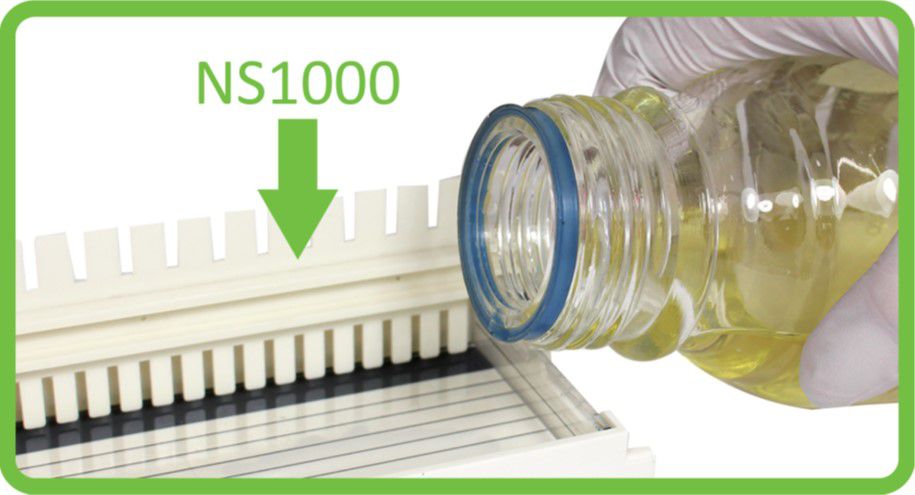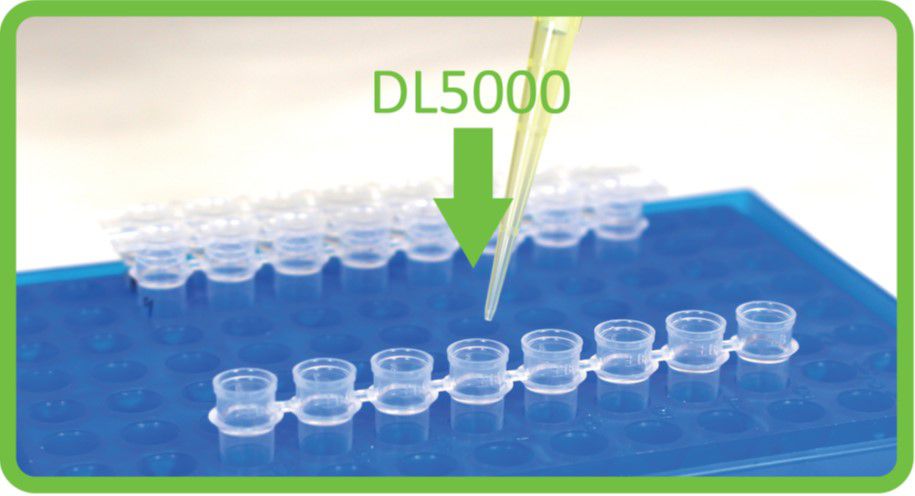[DM2300] ExcelBand™ 100 bp+3K DNA Ladder, 500μl
Description
The DM2300 ExcelBand™ 100 bp+3K DNA Ladder is a ready-to-use DNA ladder, which is pre-mixed with loading dye for direct gel loading. The DNA ladder DM2300 is composed of 12 individual DNA fragments: 3k, 1.5k, 1k, 900, 800, 700, 600, 500, 400, 300, 200 and 100 bp derived from a mixture of PCR products and specifically digested plasmid DNA. This product contains two enhanced bands (1.5 kb and 500 bp) for easier reference. In addition, two tracking dyes, Xylene cyanol FF and Orange G which mimic the migration of 4,000 bp and 50 bp dsDNA during electrophoresis are also added for real time monitoring.
Features
Sharp bands
Quick reference— enhanced bands
Ready-to-use— premixed with loading dye for direct loading
Stable— room temperature storage over 6 months
Source
Phenol extracted PCR products and dsDNA digested with specific restriction enzymes, equilibrated in 10 mM Tris-HCl (pH 8.0) and 10 mM EDTA.
Range
100 ~ 3,000 bp
Concentration
56 µg/ 500 µl
Recommended loading volume
5 µl/ well
Storage
Room temperature for 6 months
4°C for 12 months
-20°C for 36 months
Heading Sample
Specification
Cat. No. | DM2300 |
Series Name | ExcelBand™ |
Product Size | 500 μl |
Size Range | 100 – 3000 bp |
Band Number | 12 |
Tracking Dye | Orange G and Xylene cyanol FF |
Enhanced Band | 500 and 1500 bp |
Are the DNA markers/ladders produced by SMOBIO sufficient in quantity?
Yes, all the DNA markers of SMOBIO have been passed in the QC processes including repeated optical density measurements to ensure the quantity of total DNA.
Are the SMOBIO's DNA markers/ladders compatible to radio-labeling (for example, label DNA with T4 Polynucleotide Kinase)?
We do not recommend to do the labeling reaction directly.
The reasons are as follows:
Our DNA marker is pre-mixed with loading buffer that contains Tris-HCl, EDTA, and glycerol, may affect radio-labeling.
Our DNA marker is a mixture of PCR products and restriction enzyme digested DNA fragments. Digested dsDNA may still have phospho-group on their 5' end.
To enhance the efficiency of the labeling reaction, here are two steps suggested being done prior to the labeling reaction:
Purify DNA marker by EtOH precipitation or DNA purification kits to remove loading buffer.
Remove phospho-group by using phosphatase, ex CIAP (Calf intestinal alkaline phosphatase)
Are SMOBIO's DNA markers/ladders suitable to use in DNA PAGE?
SMOBIO's AccuBand™ series DNA markers (DM1200, DM2000, DM2200 and DM2400) are suitable for DNA PAGE.
Why DNA markers/ladders are resolved two bands at the same size when using high percentage agarose or polyacrylamide gel?
DNA fragments with identical in size are indistinguishable on agarose gels, but, on acrylamide gels, even slight differences in DNA sequence can lead to noticeably different migration rates. To provide increased intensity of DNA marker/ladder bands, multiple DNA fragments with identical in size but different in DNA sequences are used. SMOBIO's AccuBand™ series DNA markers (DM1200, DM2000, DM2200 and DM2400) are more suitable for DNA PAGE.
Are SMOBIO's DNA markers/ladders suitable to use in denaturing DNA PAGE?
SMOBIO's AccuBand™ series DNA markers (DM1200, DM2000, DM2200 and DM2400) are suitable for DNA PAGE.
SMOBIO's AccuBand™ DNA markers are not at denatured form, therefore, you need to denature DNA ladder by yourself.
Here is the protocol to denature DNA ladder:
Mix 5 μL of DNA Ladder with an equal volume of denaturing solution [95% (v/v) formamide, 10 mM EDTA (pH 8.0), 0.1% (w/v) bromophenol blue, 0.1% (w/v) xylene cyanol].
Incubate at 70°C for 5 minutes.
Electrophorese the sample in a denaturing polyacrylamide/urea gel
Ya-Mei Chen, Jia-Ling Wu, Wei-Hao Lin Animals (Basel). 2024 May 15;14(10):1469. doi: 10.3390/ani14101469.
PMCID: PMC11117349
Poothana Sae-Foo, Supawit Triwutanon, Theera Rukkwamsuk
Animals (Basel) 2024 Mar; 14(5): 809. Published online 2024 Mar 5. doi: 10.3390/ani14050809
PMCID: PMC10931411
Sensitive detection of specific cell-free DNA in serum samples from sheep with cystic echinococcosis
Mahboubeh Hadipour, Hossein Yousofi Darani, Hamid Talebzadeh, Mohammad Eslamian, Shima Aboutalebian, Majid Fasihi Harandi, Hossein Mirhendi
PLoS Negl Trop Dis. 2023 Oct; 17(10): e0011715. Published online 2023 Oct 19. doi: 10.1371/journal.pntd.0011715
PMCID: PMC10617735
Investigation of the Proportion of Brucella abortus and Brucella melitensis in Sheep and Goat Milk
Saeid Rostami, Ehsan Rashidian, Amin Jaydari, Heidar Rahimi Vet Med Int. 2023; 2023: 6751152. Published online 2023 Nov 24. doi: 10.1155/2023/6751152
PMCID: PMC10691893
Takayoshi Kuwabara, Hiroki Kohno, Masatsugu Hatakeyama, Takeo Kubo.
Sci Adv. 2023 May; 9(18): eadd4201. Published online 2023 May 5. doi: 10.1126/sciadv.add4201
PMCID: PMC10162674
Effectiveness of blocking primers and a peptide nucleic acid (PNA) clamp for 18S metabarcoding dietary analysis of herbivorous fish
Chiho Homma, Daiki Inokuchi, Yohei Nakamura, Wilfredo H Uy, Kouhei Ohnishi, Haruo Yamaguchi, Masao Adachi, PLoS One. 2022 Apr 20;17(4):e0266268. doi: 10.1371/journal.pone.0266268. eCollection 2022.
PMCID: PMC9020718
The Morphological and Genetic Variation of a Species of Lettuce (Lactuca undulata Ledeb.): Geographically Widespread but Locally Endangered
Morteza Mofid, Bojnoordi Seyed, Mohammad Fatemi, Mahnaz Aghdasi, J Genet Resour. Winter and Spring 2022 Volume 8, Issue 1
Pages 57-68 doi: 10.22080/JGR.2021.22300.1281
IRF3 Knockout Results in Partial or Complete Rejection of Murine Mesothelioma
Masaya Aoki, Licun Wu, Junichi Murakami, Yidan Zhao, Hana Yun, Marc de Perrot J Clin Med. 2021 Nov 7;10(21):5196. doi: 10.3390/jcm10215196.
PMCID: PMC8584553
Fariba Taheri, Abdulghaffar Ownagh, Karim Mardani Iran J Microbiol. 2021 Aug;13(4):480-487. doi: 10.18502/ijm.v13i4.6972.
PMCID: PMC8421589
Seyed Sajjad Aghayan, Hamidreza Kalalian Mogadam, Mozhgan Fazli, Davood Darban-Sarokhalil, Seyed Sajjad Khoramrooz, Fereshteh Jabalameli, Somayeh Yaslianifard, Mehdi Mirzaii Avicenna J Med Biotechnol. 2017 Jan-Mar; 9(1): 2–7.
PMCID: PMC5219818

FluoroVue™ Nucleic Acid Gel Stain
Excellent for in-gel staining
Sensitivity up to 0.14 ng DNA or 1 ng total RNA
A safer alternative to EtBr
Suitable to blue or UV light

FluoroStain™ DNA Fluorescent Staining Dye
Excellent for post staining
Sensitivity up to 0.04 ng DNA
A safe alternative to EtBr
Suitable for blue or UV light

FluoroDye™ DNA Fluorescent Loading Dye
Excellent for premix with DNA sample
Sensitivity up to 0.14 ng DNA
Safety dye
Convenience - monitor the electrophoresis in real-time

![[DM2300] ExcelBand™ 100 bp+3K DNA Ladder, 500μl](/web/image/product.template/220/image?unique=1856a2e)

![[DM2300] ExcelBand™ 100 bp+3K DNA Ladder, 500μl](/website/image/product.template/220/image/90x90)



